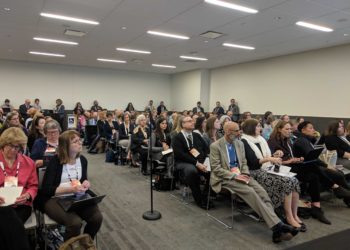Last month, I participated in an Society for Scholarly Publishing (SSP) DC Regional Event focused on the changing work environment and what we are expecting when it’s time to head back to the office.
Pages and pages have been written about what “return to normal” might look like, and what has changed so drastically in the past 18 months that we may never go back to. We talk about this a lot at the American Society of Clinical Oncology (ASCO). Without a doubt, more time has been spent senior management meetings discussing old work policies that need to change, how we can be flexible, what it means to be remote, the difference between remote work and work from home, than any other topic.
These conversations aren’t unique to ASCO and I am sure they are happening at your organizations as well.

Back to the DC Regional Event… I was happy to participate as a speaker alongside Jack Farrell, Managing Director of Jack Farrell & Associates. Jack and his colleagues have played a role in many of our lives, either by finding us qualified job candidates or presenting us as candidates in our career advancement. Jack brought his perspective and shared what he is hearing from organizations — more remote work — as well as harbingers for change — living in the DC or NY area is not necessarily an advantage anymore.
Another speaker was Jess Okeze, Associate Director of Human Resources at the American Political Science Association (APSA). I can tell you that HR professionals have had their work cut out for them. Rules change. Recommendations change. Employees have relocated during the pandemic causing shifts in work rules and tax implications. It’s a bit of a mess.
What I want to talk about a bit today, was advice that Jess gave in moving forward: be intentional.
I have been thinking a lot about what that means as we navigate issues around office re-opening. When the pandemic started and everyone was sent home– largely around March 13, 2020, for most of us on the East coast of the United States — nothing was intentional. Since that day, we are all self-taught on how to work during unprecedented times.
Last month, we had our first hybrid department heads meetings at ASCO. About half the vice presidents and executive leaders were in the office and half logged in from home. We are currently in a “soft opening” phase at ASCO. People can work at the office a little easier than before, but no one is required to come in.
The meeting was awkward. No one at home could hear side conversations and everyone in the office was on a single camera. The in-person folks had to remember to turn on their microphones so we could hear them, but when other spoke from home, there was an echo. People largely stopped chiming in from home.
As these meetings have continued, we have gotten better at them, but we have all seen versions of this happen, even in all-remote scenarios. One person typically has a connection issue or an echo. This may be their fault for logging in via computer and phone, or may be for mysterious reasons that can’t easily be diagnosed. We used to spend a minute or two trying to trouble-shoot for that person, but 18 months in, our inclination is to write them off — mute them and tell them to use the chat.
After that first department heads meeting, I kept thinking about Jess telling us to be intentional. There are 22 people on my team. Some are remote and live outside of the DC area. I’ll be honest, I don’t even completely know who on my team is a remote employee. I started almost exactly a year ago when everyone was already home, so it makes no difference.
Companies with mostly in-person staff are facing big decisions that seem to fall into the following categories:
- Everyone local will eventually come back to work in person
- Everyone is going to be remote/work from home and the office space is being significantly downsized or eliminated
- Flexibility is imperative — more people will work from home, regardless of where they live, either full-time or part-time, but we don’t want to be an all-remote organization
If we are going to be intentional about our next steps, we need to be honest with what that means. We may feel like our teams have done great over the last 18 months and that may be true. But everyone being at home at the same time is way different than some or even most people being at home with the others on-site.
Employees at home should not feel like they are working in a vacuum, and employees at the office should not feel like extra burdens (or advantages) have been heaped on them. This is where we need to be intentional.
Here are a few things I have been thinking about over the last few weeks.
In-office Tasks
Who will be responsible for the “in-office” work — filing journal copies in the office library, getting the mail, preparing for in-person meetings, etc.? Does that typically fall to one person and is that person already “in-office” or are they remote now? We must not allow an environment in which the person who chooses to go into the office is now being asked to get there at 7 a.m. to set up the catering for an on-site meeting when those aren’t their responsibilities. Don’t ask one person to now be responsible for collecting, sorting, and scanning mail just because they find working in the office to be more convenient.
Hybrid Meetings
Think about how you want meetings to go. If participants are half in and half out of the office, should everyone log in via video on their own devices? Will those in-person still be in a room together? What equipment is needed? Does someone need to be “assigned” to monitor chat and hand raising? I suggest these rules be made as a group and stated in meeting invitations until everyone gets the hang of it. Keep checking in with the team to ensure that it’s working for them. Pay attention to who contributes and who does not to try and determine if this is a change in behavior and if a simple change in meeting structure might benefit them.
Incentives for In-person
Should we incentivize coming to the office? If we don’t want to be an all-remote organization or team, then we might feel the need to give people a reason to want to come to the office. As well intentioned as this may seem — bringing in food trucks, having an ice cream social, planning an in-person coffee chat or after-hours social event — much consideration must be given to those that don’t feel safe or comfortable coming in. As of today, vaccines are not available to everyone, for example, small children. Folks who have small kids at home and are still having to take significant precautions should not be made to feel bad about that.
Performance Issues
Some people don’t do well working from home. They may have gotten a pass on performance issues over the last 18 months, particularly if there are extenuating circumstances with shared home space, internet bandwidth issues, or caregiving responsibilities at home. Now would be a good time to reset expectations.
In-person Requirements
Evaluate truthfully what work actually needs to be in-person. The ASCO policy prior to the pandemic was that people were expected to be in the office for quarterly all-staff meetings, performance evaluations, and team building exercises. If their job required them to meet with members at headquarters, they were expected to be in the office. For the last 18 months, staff meetings, performance evaluations/job interviews, and team building exercises have been done in an all-virtual environment. Is it reasonable to go back to these requirements now?
Office Space
Office space is a very touchy topic. Even if staff indicate that working from home more or most of the time is preferred, there are people that will feel significantly disconnected if they don’t have a dedicated office space. I am not saying that a company moving to almost an entirely remote situation needs to maintain dedicated spaces for people that aren’t sitting at a desk every day. What I am finding is that for some people, even people that might only plan to be in the office 2-3 times a week, having their own space with their own stuff in it is important to them. It makes them feel part of something. If you don’t have to take it away, then don’t.
Resist the urge to force everyone into a “hoteling” situation without considering the ramifications. If you need to make a change due to downsizing office space, think about having lockers or some other space where people can keep the things that make them feel most comfortable at their desk. (A friend was lamenting that her company got rid of permanent seating assignments. She carries a ridiculous amount of stuff to work on her in-office days and is starting to think it’s not worth going in.)
Fairness and Training
Most of all, we need to make sure we are being fair. The boss that likes to work from their vacation home should not have different rules applied to them.
Train supervisors on how to manage hybrid teams. This is all new and there will be mistakes made. It’s not just supervisors that benefit from training in this new environment. We all need to be intentional about being inclusive. Again, hybrid is not the same as everyone remote. It’s a whole lot harder to remember to loop people in that aren’t sitting in front of you.
As the summer wraps up, more and more companies have office opening dates on the horizon. Some of these plans may be delayed thanks to the Delta variant. While we all had to improvise on the job at the beginning, we have a chance to make our best efforts at being successful going forward.
I want to thank Adrienne White of ASCO and Jon Gurstelle of APSA for organizing the event and facilitating the discussion.
Discussion
3 Thoughts on "Transitioning Back to In-office Work Requires a Plan"
Technically speaking, I don’t manage a team. But for over 20 years, I’ve collaborated with hundreds (thousands?) of authors and reviewers all over the globe. I have no real power over any of these people. And the vast majority I’ve never even met, let alone worked in the same office. But the one thing we all do to keep the machinery humming is: RESPOND QUICKLY AND EFFECTIVTLY TO EMAIL. If ‘knowledge workers’ learned how to use email — how to write it, when to send it, who to send it to (and who not to send it to), etc. — many of these traditional (i.e., trivial) office issues would disappear. (And don’t even get me started on the reply-all function!)
Great article. Some of the things that we have continued to do at ASCE for those who continue to come into the office and more recently as others have returned to the office are the food trucks, events either online or at the office. Great points on Hybrid meetings. Since the start of COVID are meetings are virtual. In the last couple of months, during a meeting one or two of the attendees were in the office. During these meetings, they logged in separately. It will definitely be a learning curve with meetings when more return to the office.
I think one aspect is work hours. There’s a lot of consideration and discussion about how the flexibility of WFH means you can adjust your hours (sometimes useful if you have to pick people up from camp) but it also seems to cause an increase in work hours. So I think one step that those remaining WFH should do, is note how much time they are spending on work, just to make sure it doesn’t take up all the time.



